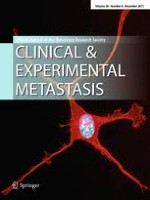Published in:

01-12-2011 | Research Paper
Laminin α5-derived peptides modulate the properties of metastatic breast tumour cells
Authors:
Nicole Kusuma, Robin L. Anderson, Normand Pouliot
Published in:
Clinical & Experimental Metastasis
|
Issue 8/2011
Login to get access
Abstract
The basement membrane protein laminin-511 has been implicated in breast cancer progression and metastasis. To identify peptides from LM-511 that modulate the metastatic properties of breast tumours, we screened laminin alpha 5 chain-derived peptides for their ability to promote adhesion of metastatic mammary carcinoma cells. Two selected adhesive peptides, α5A13b (FHVAYVLIKF) from the LN domain and A5G27 (RLVSYNGIIFFLK) from the LG-globular domain, were further characterised for their inhibitory properties against LM-511 activities in vitro and metastasis in vivo. In vitro, these peptides strongly inhibited LM-511-dependent adhesion and migration of highly metastatic 4T1.2 mammary carcinoma cells. In addition, A5G27 but not α5A13b significantly reduced breast tumour cell proliferation and inhibited laminin-511-induced matrix metalloproteinase-9 expression. Surprisingly, despite its potent inhibitory activity in vitro, A5G27 promoted rather than inhibited 4T1.2 experimental pulmonary metastasis in vivo, regardless of its route of administration. Adhesion of 4T1.2 cells to A5G27 was not inhibited by antibodies directed against α6, β1 or β3 integrins or CD44 but was significantly reduced in the presence of heparin suggesting a role for cell surface glycans. Treatment of the cells with α-l-fucosidase but not neuraminidase or heparinase II also partially inhibited cell adhesion to A5G27 and to LM-511 indicating that these interactions are mediated in part via terminal fucosyl residues. Overall, these results show that LMα5 peptides exhibit distinct functional properties in vitro and in vivo and suggest that interactions between the RLVSYNGIIFFLK sequence present in LM-511 and cell surface glycans may regulate LM-511 metastatic properties in vivo.